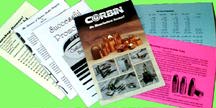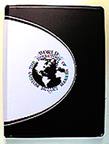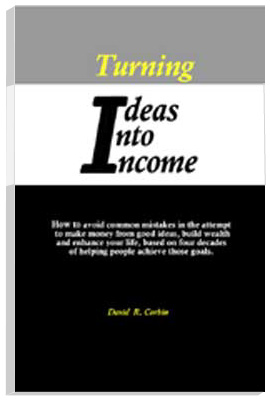Concentrate on value, not price.
The first word in the term "custom bullet maker" is the key to success.
There is always room for the best.
In every field, for every market, there is a top end. Why can't it be your product?
Sales are more stable at the top.
If you choose customers who will never be in the soup lines, you can always buy plenty of soup.
|
Anyone can work for less. If your goal is only to make the same thing cheaper than the other guy, you are doomed to working harder for less money in a risky downward spiral, where the ultimate goal would be free products and infinite work.
Why not concentrate on value? Offer a product that the competition does not have. It is not hard to come up with unusual bullet designs, weights, shapes, and styles, or materials like plastic, tungsten powder, copper and tin instead of lead. It is not hard to see that making a higher priced product in smaller quantity is less work than selling lots of cheap products. The trick is in realizing that you are offering value, not price, as the selling point.
Many people completely miss this critical point, and go broke beating themselves, instead of finding a market where people want something better, more suited to their needs, than the low-profit products everyone else buys. If you want to be a mass marketer, then selling high volume at low profit is good. But if you want high profit, low stress, and less effort for a home business, then meeting the needs of a few people who are willing to pay you well for your work is far better.
|
Choose markets with high reward per shot.
Your best clients buy fewer bullets, but value them higher.
Think like the client you want.
What you want for yourself, lower price, may be way down the list of what your best clients want in a bullet.
Work smarter, not harder.
Anyone can sell cheaper until they are paying clients to take away product. How smart is that? Learn to sell features instead of price.
|
One of the first errors people make is to ask "How many bullets can I make an hour?" when the real question should be "How much money can I net per hour?". Do you want to make lots of bullets, or lots of money? The highest volume markets pay the least per bullet. This is because markets where volume is most important also place very low value on each shot fired.
The reward for each plinking bullet fired, each practice target round shot, is minimal because you must fire so many to become a successful competitor. No one shot is going to make that much difference to the outcome of your next match. And even if it could, the number of shots you must fire in competition would make it prohibitive for you to pay as much for target bullets as you would pay for a defense or big game bullet.
In home defense, law enforcement, big game hunting, and a few other markets, the reward placed on each shot fired is extreme. It ranges from life and death, to wasting or winning a major game trophy (which, at today's guided hunt costs, could amount to anything from $1500 to $25,000). Because relatively few shots are fired, and the value of each shot is so high, you can sell bullets at prices that could not be considered by the target shooter, plinker, or casual weekend shooter. Prices of over $1.50 per bullet are not uncommon in these markets.
|
Test and develop before taking orders.
A good product ready to ship builds loyalty.
Know what you are selling.
The way to know your product is to use it, learn its strong and weak points.
Stress the benefits of your product.
The benefits are not specifications or hyperbole. Benefits are what users find useful.
|
Very often a client will have an idea "on paper", perhaps even obtain a patent, and begin marketing and taking orders before the equipment to build the bullet has even been developed. This is a very serious error. In bullet design, there are often surprises. What appears logical and scientific may in fact not work as expected, or may be far too hard to build.
It is always important to have the tools in hand before you start advertising and setting up hunts or other activities to promote the product. And once you have the tools, it is critical that you spend some time with them, actually building the bullets and experimenting with them, to see if they really do what you expect. If not, you have plenty of time to make changes, to discover what does work, before putting yourself in a tight spot between orders and possible equipment or material changes.
It is human nature to rush when you have spent money and want to make it back quickly. But it is far more wise to plan your purchase so you do not need to make it back for a while. Wait a little longer to buy, if necessary, so you can save enough to keep you from worrying about loan payments. Get the most versatile equipment, over-doing it a little, so that you have plenty of available power and strength in the dies and presses. It is never much of an error to have better equipment than you really need. It is always a mistake to have less.
Second guessing how things are going to go, before you try, can lead you down blind alleys. You need to keep an open mind, and test before deciding what works, and what does not. This can take weeks or months. It is not pleasant to have angry customers waiting for products that you are not even sure will do what you promised. It is far better to find out by testing what your ideas will do, and then offer solid proof of your tests. It is also far better to have worked out all the rough spots, and come up with the easiest way to make the products, before you start taking orders.
|
Once you decide, stay the course.
Take as long as necessary to decide. But decide.
Most people quit before they have a chance to succeed.
Success is primarily a matter of perserverance.
Get all the help available.
Corbin's Marketing Information Pack (MIP) is yours for shipping/handling cost of $4.

|
The indecisive client is the one we worry about constantly, because the self-doubt about his decision to go into bullet making, about the design of bullet or the caliber selected, about the market or the size of equipment he can afford, usually leads to a series of changes in the pending orders. This means a lot of wasted effort on our part, and long delays in finally getting the latest decision of the moment into that client's hands.
But worse than that, a person who is half decided and orders anyway is a person who is not committed to success in his business. Wanting success is not the same thing as being committed to it. Success does not necessarily come with the first attempt. A person who is uncertain is one who may give up far too soon.
In the early days of my writing career, I often submitted the same article to five or six magazines, one at a time, before having the article accepted for publication. The standard rejection notice seldom let me know what was really wrong. Later, when publishers called me with assignments rather than my having to seek them out, I learned that often, the only reason my earlier work was rejected was because the magazine had plenty of "stock" on hand from staff writers, had committed all its resources for the quarter, had something too similar to my article already in the works, or some other reason that had nothing to do with the quality of my writing. But sometimes, an editor would send me a critique that helped me understand that there was an error in my approach, and I would learn from it. Once in a while, the critique was only valid for that particular magazine or publishing house, and the same article was purchased unchanged by someone else. I had to learn to decide for myself if the experts were right in general or just in a specific set of circumstances that would soon change.
Self-doubt can paralyze good ideas. But blindly pushing bad ideas forward can lead to eventual disappointment. The trick is to do as much study as is reasonable and prudent, and then make a decision, and commit to it. If the idea is really no good, it should take more than a couple of rejections to prove it. Many rejected ideas eventually are massaged and marketed properly and become huge winners. You may have to make minor changes but in the custom bullet field, if you stick with it, you will usually prevail.
|
Promote until you drop!
If you don't toot your horn, no one else will.
Even slot machines pay a little if you keep pulling.
The key is putting more productive effort and less cash into your publicity. A slot machine may give you back 90 cents for each dollar invested, on average, but a press release can pay you back ten thousand times.
Advertising is the price of free publicity.
Eventually, your news value wanes. Buying a minimum amount of ad space helps you get better free publicity when you ask for it. Ask often and loudly. All they can say is yes or no.
|
Our most successful clients usually do not have any better product idea than anyone else. They are not necessarily richer, smarter, nor do they start out spending more money on equipment. They do not necessarily buy more advertising or know more people in the trade.
The one thing that stands out among our most successful clients is their willingness to promote their products. Going to trade shows, seeing distributors, showing the product over and over to dealers, calling potential business buyers and resellers over and over, and primarily, sending press releases, samples, photos, letters, and calling writers and editors (of new product columns especially), is something they do constantly.
The one thing you can do that costs very little compared to the reward is to prepare a good brochure and price list (do not skimp on the printing or design cost, because a cheap brochure says you have a cheap product, and you want to offer value), and to bombard popular gun writers, editors, and publishers with your product information and press releases. Sadly, this is about the last thing that most clients would do on their own. And it is critical to success.
If you are not good at writing and photography, layout and design of brochures and sending information to writers, hire someone who is. Advertising agencies and publicists will do this for you for a reasonable fee. If you don't like to brag, don't worry, you are not bragging when you tell the truth in a good light. Your product is just as good as anyone else's and probably better. You need to let people know why they should buy it. What will it do for them? How does it do this better than other offerings?
If you don't want to spend the money, why are you in business? You won't be there for long unless people know about you and are convinced you have something they need.
|



 A comprehensive book about the commercial bullet business is called
"The World Directory of Custom Bullet Makers". It
is in a 6-inch by 9-inch 3-ring binder format with many sections, or sub-books, inside it. The content includes these sections...
A comprehensive book about the commercial bullet business is called
"The World Directory of Custom Bullet Makers". It
is in a 6-inch by 9-inch 3-ring binder format with many sections, or sub-books, inside it. The content includes these sections...
 Turning Ideas Into Income
Turning Ideas Into Income